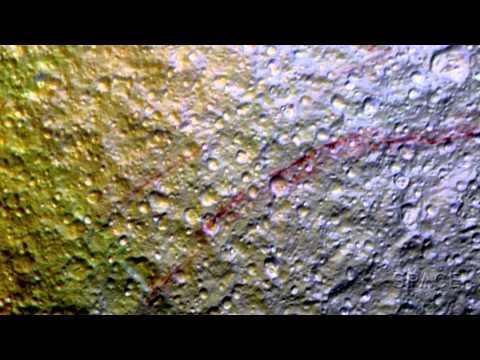This is a bit more of the lineage of the findings and mission studying Saturn:
A few of the red arcs can be seen faintly in observations made earlier in the Cassini mission, which has been in orbit at Saturn since 2004. But the color images for this observation, obtained in April 2015, are the first to show large northern areas of Tethys under the illumination and viewing conditions necessary to see the arcs clearly. As the Saturn system moved into its northern hemisphere summer over the past few years, northern latitudes have become increasingly well illuminated.
Wikipedia has some background on this fascinating moon:
Tethys or Saturn III is a mid-sized moon of Saturn about 1,060 km (660 mi) across. It was discovered by G. D. Cassini in 1684 and is named after the titanTethys of Greek mythology.
Tethys has a low density of 0.98 g/cm3, the lowest of all the major moons in the Solar System, indicating that it is made of water ice with just a small fraction of rock. This is confirmed by the spectroscopy of its surface, which identified water ice as the dominant surface material. A small amount of an unidentified dark material is present as well. The surface of Tethys is very bright, being the second-brightest of the moons of Saturn after Enceladus, and neutral in color.
Tethys is heavily cratered and cut by a number of large faults/graben. The largest impact crater, Odysseus, is about 400 km in diameter, whereas the largest graben, Ithaca Chasma, is about 100 km wide and more than 2000 km long. These two largest surface features may be related. A small part of the surface is covered by smooth plains that may be cryovolcanic in origin. Like all other regular moons of Saturn, Tethys formed from the Saturnian sub-nebula—a disk of gas and dust that surrounded Saturn soon after its formation.
What do you think caused these unusual red lines?
thanks to phys.org for the great info
thanks to NASA for the pic
